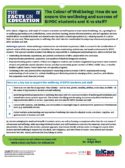The Colour of Wellbeing: How do we ensure the wellbeing and success of BIPOC students and K-12 staff?
Download the Fact Sheet! (270.52 kB / pdf)
DownloadBIPOC (Black, Indigenous, and People of Colour) K-12 students and staff experience lower levels of wellbeing. Yet, a growing focus on wellbeing approaches such as mindfulness, social-emotional learning, trauma-informed practices, and self-regulation can have harmful effects on racialized students and educators and may lead to cultural appropriation (i.e. adopting aspects of a culture that’s not your own). These approaches to wellbeing often don’t take into consideration the unique experiences and perspectives of BIPOC students and staff.
Wellbeing is systemic. When wellbeing is understood as one individual’s experience, it fails to account for the harmful effects of systemic racism, White supremacy, and colonialism that create unwelcoming, exclusionary, and unsafe environments for BIPOC students. This approach absolves systems from taking any responsibility in creating and perpetuating harm, which could look like:
- Overlooking the histories, experiences, and positive contributions of BIPOC people within the curriculum
- Disproportionate punishment, suspension, and expulsion of Black and Indigenous students
- Disproportionately greater numbers of Black and Indigenous students, and students marginalized by poverty in lower academic streams and particular special education classes, and disproportionately greater numbers of White, middle-class, or wealthy families in gifted classes, French Immersion, and specialty programs.
- Continuing to hire and promote White employees for leadership positions instead of BIPOC employees with strong understandings of anti-racism (i.e. actively identifying and eliminating racism by changing policies, practices, and attitudes that perpetuate racist ideas and actions).
Here are 4 key tips to support the wellbeing of BIPOC students and staff:
1) There is no one-size-fits-all approach. Place identity – such as race, gender, sexuality, abilities, social class, and faith – at the center of approaches to student and staff wellbeing.
2) Avoid taking individual approaches to wellbeing that place both the source and solution of wellbeing with individuals and instead take a more systemic approach. This includes identifying and disrupting structures and policies that have had disproportionate effects on access, opportunity, and outcomes for BIPOC students and staff.
3) Connect with students, staff, families, and communities in meaningful ways to understand the experiences of institutional harm (e.g. residential schools).
4) Embed multiple understandings and approaches of wellbeing that value the physical, social, emotional, cognitive, and spiritual needs of students and staff.
By not acknowledging the depth and breadth of systemic racism, we end up focusing on symptoms rather than the root causes of achievement and wellbeing, while expecting individual students and staff members to overcome the numerous structural barriers placed before them. When schools take a systemic approach, they instead identify and take action to change the ways in which student and staff wellbeing is impacted by anti-Black, anti-Indigenous, and other forms of racism. Every student and educator deserves to feel safe, valued, and know that they belong at school.
Additional Information and Resources
Anti-racism: the active identification and elimination of racism and intersecting forms of oppression, by changing systems, structures, policies, practices and attitudes, for the equitable redistribution of power and resources.
Streaming means that students are placed into groups defined by their ability levels. Students may be grouped by ability either for a subject (for example for mathematics or reading) or for all or almost all their instruction. Students’ assignment to an ability group may be temporary, changing during the year, or relatively permanent.
White supremacy refers to a political, economic and cultural system in which Whites overwhelmingly control power and material resources, conscious and unconscious ideas of White superiority and entitlement are widespread, and relations of White dominance and non-White subordination are daily re-enacted across a broad array of institutions and social settings (Ansley as cited in Gillborn, 2016, p. 48).
Colonialism: systems and practices that seek to impose the will of one people on another and to use the resources of the imposed people for the benefit of the imposer. Colonialism can operate within political, sociological, economic and cultural values and systems of a place even after occupation by colonizers has ended (Assante, 2006).
- Faculty of Education Summer Institute 2020-21 Webinar Decolonizing Mental Health – https://fesi.blog.yorku.ca/november-25th-2020-webinar/
- VoicEd Equity Podcast Series – https://voiced.ca/project/rsekn-equity-podcast-series/
- Documentary: This is Not a Resilience Story – https://www.youtube.com/watch?v=7wkh1sxKGxI
- https://thunderbirdpf.org/first-nations-mental-wellness-continuum-framework/
- https://smho-smso.ca/wp-content/uploads/2020/09/Understanding-Anti-Black-Racism-For-MHL.pdf
- http://www.ontariodirectors.ca/downloads/Listening_Stone/Dion_LS_Final_Report%20Sept_10-2014-2.pdf
- https://ofifc.org/?research=trauma-informed-schools-in-indigenous-contexts-module
- https://www.raiseyouraq.ca/files/2017/04/Towards-Race-Equity-in-Education-April-2017.pdf?x60002
- https://thelearningexchange.ca/partnering-for-black-student-well-being-a-teachers-journey/
- https://issuu.com/ontarioprincipalscouncil/docs/opc_fall20-aoda-final/s/11099619
- https://www.cbc.ca/player/play/935078979530/
References
Dei, G.J.S. (2008). Schooling as community: Race, schooling, and the education of African youth. Journal of Black Studies, 38(3), 346-366.
Dion, S. (2014). The listening stone: Learning from the Ontario Ministry of Education’s First Nations, Métis and Inuit–focused collaborative inquiry 2013-2014. http://www.ontariodirectors.ca/downloads/Listening_Stone/Dion_LS_Final_Report%20Sept_10-2014-2.pdf
James, C. E. (2012). Students “at risk”: Stereotyping and the schooling of black boys. Urban Education, 47(2), 464-494.
James, C.E. & Turner, T. (2017). Towards race equity in education: The schooling of Black students in the Greater Toronto Area. https://edu.yorku.ca/files/2017/04/Towards-Race-Equity-in-Education-April-2017.pdf?x60002
Thompson, R. (2020, Sept. 29). Addressing trauma in the K-12 workplace: The impact of racial trauma on Black and non-white educators. https://www.edcan.ca/articles/addressing-racism-in-the-k-12-workplace/

